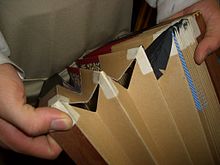bellows
A bellows or bellows for short is a device for generating a blast of air or a stream of air. The name bellow comes from the animal skins that were originally used to make it.
A bellows consists of a deformable body fitted with one or two valves. Air is sucked in through one valve as it expands and blown out through the nozzle when it is compressed. A second valve in the nozzle prevents some of the air from flowing back during opening. The earliest forms were completely without valves, the operator had to close the inlet opening by hand so that the inlet opening was mostly in the handle. Early forms consisted of wood and leather , nowadays bellows are mostly made of plastic . An advanced and automated form of bellows is the diaphragm pump .
history
Bellows were particularly since the Middle Ages in forging used the embers in the hearth to bring to the correct temperature. For iron production in Europe, water-wheel-driven blowers were used as early as the beginning of the 13th century, in which the cams of a camshaft raised the overhead board of a bellows, which was then pushed down again by weights on top. In addition, water drum blowers were also used in forges . The increased supply of air oxygen compared to pure heat convection led to an increase in the temperature of the embers. However, the bellows were also needed in every household in order to rekindle the embers of the open hearths and chimneys with a targeted blast of air in the morning.
Instrument making
Organ, harmonium

The wind mechanisms of the organ instruments consist of a wide variety of bellows, they were operated by Kalkanten before electrification . A distinction is made here between wind-generating bellows and regulating magazine bellows . Fluctuations in air pressure are sometimes balanced out with so-called float bellows.
With the harmonium, the player uses two foot-operated bellows to inflate another bellows inside the instrument, which then evenly releases the air flow necessary for the operation of the instrument.
accordion

With hand-drawn instruments , the bellows is located between the bass part and the treble part of the instrument. Depending on the type of instrument, it is adapted in size and appearance to the rest of the instrument. It usually consists of evenly deep folds. The number and depth of the folds vary greatly between the different instruments. The basis, however, is almost always made of folded cardboard, which is flexibly connected in the corner joints with very thin, airtight leather. For very cheap instruments, artificial leather is used instead of leather.
The outer corners are usually reinforced with metal corner protectors or, on some instruments, with leather. The surface of the folds can be reinforced and embellished with different materials both inside and outside. At both ends of the bellows there is a wooden frame that connects to the respective instrument parts.
There used to be a separate trade for bellows makers, today instrument bellows are almost exclusively made by the instrument makers themselves, but the more labor-intensive tasks are mostly outsourced to home workers. There are still a few companies in Europe that have specialized in the manufacture of instrument bellows.
Outside Europe, various other types of bellows were known, but they are based on the same principle.
Bagpipe
The bagpipe or the bagpipe is also often supplied with air by a bellows.
reception
Gustav Otto Müller describes the bellows as an attribute of defamation and cites a painting by Louis Silvestre in the Dresden Residenzschloss as an example.
Web links
- Arndt Last: Instructions for building bellows yourself. Retrieved January 16, 2013 .
- The Romans online, two instructions for building a bellows, blacksmithing tips, ancient iron making, etc. v. m.
Individual evidence
- ^ Gustav Otto Müller: Forgotten and half-forgotten Dresden artists of the last century. Hoffmann, Dresden 1895, p. 143.


